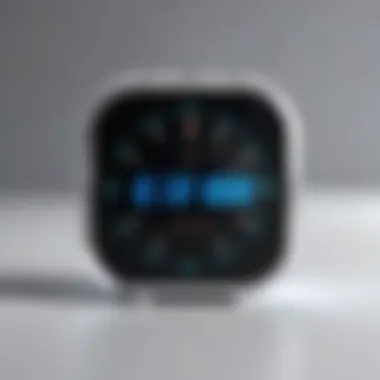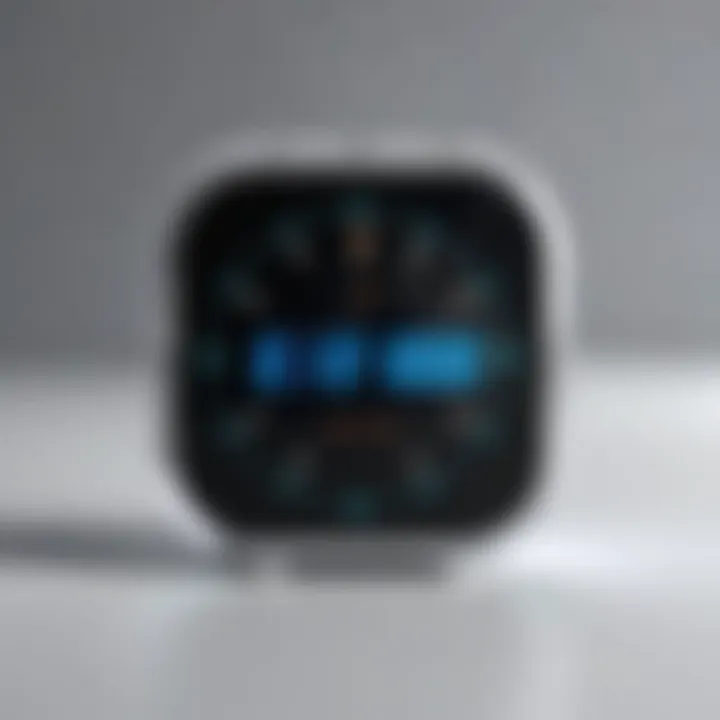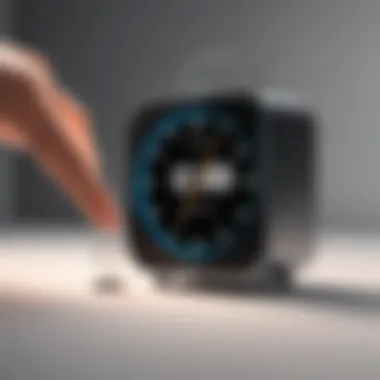The Innovative Alarm Clock That Runs Away


Intro
The concept of the alarm clock has remained relatively unchanged over decades. However, recent innovations have sparked a new breed of devices that challenge our traditional notions. One such innovation is the alarm clock that runs away. This unique gadget goes beyond merely waking you up by introducing a playful yet practical challenge to your morning routine. By analyzing its design, impact on sleep patterns, and user experiences, we can uncover the significance of this technology in our increasingly automated world.
Overview of the Technology
Key Specifications
The alarm clock that runs away comes with various features that enhance its functionality. Most prominent among these are:
- Mobility: The capable of mobility allows the device to move away from its designated spot once the alarm goes off.
- Sensors: Many models are equipped with proximity sensors to avoid obstacles while navigating.
- Battery Life: Longer battery life is essential, enabling the clock to roam freely without constant charging.
- Connectivity Options: Bluetooth and Wi-Fi capabilities allow syncing with smartphones for added functionality.
Unique Selling Points
What sets this gadget apart from conventional alarm clocks? The primary selling points include:
- Engagement: By forcing the user to physically get out of bed to stop the alarm, it increases engagement with waking up.
- Restoring Routine: The design encourages a slower transition from sleep to wakefulness.
- Design Variants: Different designs cater to diverse user preferences, allowing for personal expression.
Design and Build Quality
Material Used
The materials for these alarm clocks often vary. Plasitc and metal designs are common, providing both durability and aesthetics. Some models incorporate eco-friendly materials, appealing to environmentally conscious consumers.
Ergonomics and Usability
Usability remains a core aspect of design. Most models prioritize ease of use, featuring intuitive interfaces. The size is typically compact, allowing for placement on most nightstands. Moreover, the running mechanism is designed to be quiet, ensuring it does not disturb others during its morning ritual.
"Innovation in alarm clock design represents a broader shift towards technology that adapts to user behavior rather than dictating it."
As we progress through this article, we will continue to examine how this innovative alarm clock fits within the landscape of consumer technology. Its implications for sleep hygiene and user interaction present a fascinating area of exploration.
Preamble to Alarm Clocks
The concept of alarm clocks has transformed significantly over time, evolving from basic mechanical devices to advanced digital technology. This article's exploration of the innovative "alarm clock that runs away" rests on a foundational understanding of how traditional alarm clocks work and their historical significance. The introduction provides context for this unique design by illuminating the functional and cultural roles alarm clocks have occupied in daily life.
Alarm clocks serve a basic yet essential purpose: they help individuals manage their schedules and wake up on time. As sleep patterns and lifestyle choices have shifted, the design and functionality of these devices have also adapted. Understanding the evolution of alarm clocks reveals how consumer expectations have changed and why a novelty like a running alarm clock may resonate with contemporary users.
In examining the importance of alarm clocks, this section also considers potential benefits of innovations like the alarm clock that runs away. For some, it offers a playful approach to waking up, potentially improving engagement and reducing the tendency to hit the snooze button. Consequently, the alarm clock that runs away becomes not only a device but also a catalyst for behavioral change, encouraging users to rethink their waking rituals and sleep management strategies.
Thus, as we investigate the evolution and current types of alarm clocks, we set the stage for discussing the specific mechanisms and implications of this innovative design.
Understanding the Alarm Clock that Runs Away
The concept of an alarm clock that physically moves away from the user when it goes off presents intriguing possibilities for promoting better waking habits. This design innovation straddles the line between necessity and novelty, serving both functional and psychological purposes. By forcing the user to engage actively with their waking process, this gadget addresses common issues related to sleep inertia and resistance to early mornings.
Defining the Concept
An alarm clock that runs away can best be described as a device that features a mobility mechanism, allowing it to move away from its initial position when the alarm activates. This movement might include rolling or crawling across a surface, thereby requiring the user to get out of bed to turn it off. The primary aim of this concept is to mitigate the natural tendency to hit the snooze button, a behavior that often leads to fragmented sleep patterns and decreased productivity.
The idea stems from the growing interest in behavioral design, which explores how physical interaction can influence user habits. By turning a mundane task into an active challenge, the device capitalizes on the principles of engagement and motivation. Users must physically retrieve the alarm clock, creating a more dynamic morning routine that can lead to increased alertness and awareness.
Mechanisms of Movement


Understanding the mechanisms behind the movement of these alarm clocks is essential for grasping their effectiveness. Most designs utilize wheels or propulsion systems that allow the device to explore its surroundings after the alarm activates. For example:
- Rolling Mechanism: Some models use a simple rolling mechanism that allows the clock to move in a straight line or follow a predetermined path. This approach is often effective on hard surfaces.
- Crawling Mechanism: More advanced designs harness robotic technology, enabling the clock to traverse uneven surfaces or navigate around obstacles. This type often employs small legs or treads to simulate movement.
- Sound Activation: Many incorporate a sound detection feature, where the clock only stops moving when the user approaches or responds to specific sounds.
These movement mechanisms not only enhance the user's experience but also force engagement. Additionally, the design considerations behind these features often account for usability. Factors such as battery life, noise level, and ease of retrieval in a frantic morning environment are critical for user satisfaction. Ultimately, the effectiveness of these alarm clocks hinges on how well they fulfill their promise of encouraging a more conscious awakening.
Design Considerations
The design considerations for the alarm clock that runs away are crucial in determining its appeal and functionality. This innovative gadget diverges from traditional alarm clocks by introducing elements aimed at improving user engagement and addressing real-world sleep issues. As it nestles into an ever-evolving landscape of consumer technology, examining these considerations provides insight into why this device might resonate with users.
User Interaction and Usability
User interaction is a fundamental aspect of the alarm clock that runs away. Its primary function is to rouse users from sleep, yet doing so in a way that enhances the waking experience is vital. The idea behind a mobile alarm clock is that it forces the user to leave their comfort zone, compelling them to engage. This design creates an instinctive response, necessitating physical action to turn it off. Such design intentionally integrates a physical element, thereby making the waking moment less passive.
The usability of this gadget is not just about how it looks but rather how it performs in everyday scenarios. Users are encouraged to consider multiple elements that could define ease-of-use among various alarm clock designs. Here are some considerations:
- Intuitive Controls: Users should easily navigate through settings without confusion.
- Accessibility: Features like volume control and brightness settings must be easily accessible, especially for users with disabilities.
- Feedback Mechanism: Visual or sound prompts can assist users in understanding device status, such as whether the alarm is set or not.
By addressing these points, designers can ensure that the functionality remains at the forefront, making users feel more connected to the product while minimizing frustration.
Aesthetic and Functional Design Elements
A well-designed alarm clock that runs away must balance aesthetic appeal with functional efficiency. The interaction of these design elements creates a cohesive user experience. At its core, aesthetic design encompasses the look and feel of the device, suggesting familiarity while promoting engagement.
Functional design, on the other hand, focuses on how well the device fulfills its role in waking users up. Here are some essential aesthetic and functional aspects:
- Visual Design: The shape and color scheme of the alarm clock should attract attention while still blending into a variety of settings. A playful yet modern design can enhance user satisfaction.
- Durability: Given that the clock may be moving, materials chosen must withstand potential falls, ensuring longevity.
- Size and Portability: Compact size encourages easy placement in various spots around the home.
The balance between these two aspects stimulates user interest and supports positive responses during those groggy morning moments. Additionally, it should be noted that:
"Good design is not just what it looks like and feels like. Good design is how it works."
Psychological Implications
Understanding the psychological implications of the alarm clock that runs away is crucial. It highlights how this inventive design could impact users beyond functionality. By examining both effects on sleep patterns and the behavioral changes it induces, we can better appreciate its potential significance in the landscape of personal devices.
Effects on Sleeping Patterns
The alarm clock that runs away could potentially transform sleep habits. Conventional alarms often encourage users to hit snooze, leading to fragmented sleep cycles. In contrast, a moving alarm clock engages the user more actively, possibly prompting quicker wakefulness. By introducing an element of physical movement, the device adds urgency to waking up, which may help in:
- Reducing sleep inertia
- Improving wakefulness upon rising
- Encouraging quicker morning routines
Studies suggest that sleep inertia— the grogginess felt upon waking— can be lessened with a more dynamic approach to alarms. This mechanism can cater to those who struggle with traditional alarm clocks, thus enhancing their overall sleeping patterns.
Behavioral Changes Induced by Escape Mechanism
The escape mechanism of the alarm clock adds behavioral dimensions. As the device runs away, it creates an immediate need for action. This might lead to changes in:
- Morning behavior: Users may develop a structured morning routine, as they have to chase the alarm to turn it off.
- Time management: The urgency instilled by a fleeing alarm may lead users to adopt better time management skills, making them more punctual in their daily activities.
- Psychological readiness: The requirement to get out of bed to stop the alarm may induce a readiness to engage with the day.
Research in behavioral psychology emphasizes how challenges and incentives influence daily habits. By transforming the mundane task of waking into an interactive experience, users may find themselves more engaged and mindful about their mornings.
"Alarm clocks that require user interaction might set the stage for improved morning habits and enhanced productivity."


In summary, the psychological aspects of the alarm clock that runs away reveal its potential to influence sleeping patterns and shape daily behaviors. Understanding these implications can provide valuable insight into user experiences and the potential for future advancements in alarm technologies.
Market Trends and Innovations
The realm of alarm clocks continues to evolve, particularly with the introduction of innovative concepts such as the alarm clock that runs away. Understanding market trends and innovations in this segment is crucial for grasping how technology influences everyday life. The intersection of consumer gadgets and behavioral modifications is not only fascinating but holds significant implications for sleep culture as well.
Current Players in the Market
As with any technology market, key players shape the landscape of alarm clock innovations. Brands like Philips Hue, with its smart lighting solutions, have ventured into alarm functionalities. They combine light and sound to create customized wake-up experiences. Another notable contributor is Clocky, a playful brand that embodies the essence of the mobile alarm clock. It exemplifies how companies are employing creativity to create a more engaging user experience.
While traditional players continue to dominate, startups are emerging with fresh perspectives. Technologies such as Bluetooth connectivity and smartphone integration are becoming norms. This shift encourages manufacturers to consider how their products fit into the broader ecosystem of smart homes and personal devices. Not only do these innovations enhance user convenience, but they also underscore the importance of adapting to consumer preferences.
Emerging Technologies in Alarm Clocks
Beyond known brands, the landscape is witnessing a surge in emerging technologies that promise to redefine how people approach waking up. Many modern alarm clocks integrate features like sleep tracking and artificial intelligence, which allow for personalized alarms based on individual sleep patterns. This can help people wake up feeling more refreshed.
New designs also prioritize mobility. Alarm clocks that physically move away from the bedside when the alarm goes off encourage users to get out of bed. Such designs challenge users to engage with their waking routine, promoting a more active start to the day.
"Technological advancements in alarm clocks reflect a broader trend towards personalization and interactivity in consumer gadgets."
Market research indicates a potential growth in demand for smart alarms, driven by consumers looking for effective tools to manage their sleep health.
In summary, the market for alarm clocks is not stagnant. Recognizing the innovation occurring now allows us to appreciate how far we have come and where we might be heading. With brands shaping experiences through technology and new players introducing fresh ideas, the future of alarm clocks may just revolutionize how we wake up.
User Experiences and Feedback
Understanding the experiences of users with the alarm clock that runs away is crucial for gauging the device's effectiveness and overall impact. User feedback provides insights into design elements, functionality, and areas that require improvement. Analyzing this feedback can also reveal how well the innovative features are received by tech-savvy individuals and early adopters of technology. By collecting real-world experiences, manufacturers can enhance product iterations and address usability concerns effectively.
Case Studies of Alarm Clock Users
Examining case studies of alarm clock users highlights the varied experiences with the runaway alarm clock concept. For example, a user named Sarah, an early adopter from San Francisco, reported finding effectiveness in the movement feature. She indicated that having to physically chase the clock helped her wake up more promptly each day. Sarah's experience showcases the unique motivational aspect of this product, as it fosters a more proactive behavior toward waking up compared to traditional alarm clocks.
On the other hand, a user named Miguel from Madrid had a different perspective. He recorded that the runaway feature was often frustrating. For Miguel, the alarm's erratic movement led him to start each morning with annoyance, rather than motivation. It illustrates that user interaction varies widely and that individual preferences play a significant role in user satisfaction. These case studies can be pivotal for companies in refining designs and features that resonate with users.
Common Complaints and Praise
As with any technology, user feedback encompasses both positive and negative comments. Common praise for the alarm clock that runs away includes its innovative approach to morning routines. Users frequently express that the device encourages a healthier wake-up habit, pushing them to become more active upon rising. The excitement of racing after an alarm rather than simply stopping it can transform the waking experience.
Conversely, key complaints often focus on the device's noise level and movement patterns. Users have reported that some models can be too loud, leading to irritation rather than a gentle awakening. Furthermore, users like Emilie from London have noted that the movement mechanism may not work on certain surfaces, causing the alarm to become stuck or fail to escape effectively. This inconsistency is a substantial concern that manufacturers must address.
"User experiences reveal that an innovative design isn't sufficient; practical functionality is equally essential."
Overall, listening to user experiences and feedback is not only valuable for enhancing product design but also for aligning with consumer expectations in a rapidly evolving market. Collecting and acting upon user input helps create a more compelling product that meets the demands of tech enthusiasts.
Challenges in Adoption
In the realm of innovative technology such as the alarm clock that runs away, understanding the factors that hinder its acceptance is crucial. The concept is intriguing, yet it does not automatically guarantee that consumers will embrace it. Several challenges come into play that can influence the widespread adoption of this device.
Technological Limitations
The first and perhaps most significant barrier is technological limitations. An alarm clock that runs away relies heavily on mechanisms that enable it to move, either autonomously or through a user’s command. Creating a device that can move effectively poses engineering challenges. The intricacies involved in ensuring stability, battery efficiency, and pathway navigation are daunting. If the technology cannot perform these tasks reliably, consumers may find the product unsatisfactory.
Furthermore, the device needs to be equipped with smart features like connectivity with smartphones or integration with smart home systems. However, not all users have access to or familiarity with these technologies. This creates a gap that can hinder adoption. Therefore, developers must address these limitations with viable solutions, ensuring that the alarm clock can function optimally in different environments.


User Reluctance and Skepticism
Alongside technological hurdles, user reluctance and skepticism pose another important challenge. Many potential users may question the practicality of a device that physically runs away from them. Some might perceive it as a novelty or a gimmick rather than a functional tool.
In addition, there is a general resistance to change, especially regarding daily routines such as waking up. Traditional alarm clocks serve their purpose efficiently, and users may be hesitant to transition to a competing model that requires adaptability. Furthermore, the fear of failure or malfunction could deter the tech-savvy individual looking for reliable solutions. If users feel uncertain about how much effort is required to use the running alarm clock, they may choose to stick with traditional models instead.
It is essential to bridge the gap of skepticism by providing clear benefits and showcasing success stories from early adopters. By demonstrating how the running alarm clock effectively improves waking experiences, manufacturers may overcome initial resistance. Only then can one potentially usher in a new era of alarm clocks that redefine wakeup routines.
Comparative Analysis with Traditional Alarm Clocks
The concept of a running alarm clock presents a significant departure from conventional alarm clocks, demanding a comparative analysis of both. Understanding these distinctions is essential for grasping the relevance of innovative designs today. Traditional alarm clocks, mainly stationary devices, serve the fundamental purpose of waking users at a designated time. However, the alarm clock that runs away introduces an entirely new element of interaction and user engagement.
Benefits of a Running Alarm
- Promotes Active Engagement: One of the primary benefits of a running alarm clock is its ability to compel users from a state of sleep to an active state. Unlike standard alarms that allow for easy snoozing, the active nature of a running alarm means users must physically get out of bed, potentially improving morning routines.
- Fun and Novel Experience: The novelty of chasing an alarm can make waking up a more interactive experience. For users who find mornings drudging, this device inserts an element of playfulness that may better prepare them for the day ahead.
- Customization Potential: Many modern running alarms come with features that allow users to set various wake-up tasks. These may include specific routes for the alarm to run, thus catering to the preferences of different users and making the experience tailored and unique.
- Reduction in Sleep Inertia: The act of chasing after the alarm may stimulate the body more effectively than conventional alarms. This reduced inertia leads to a quicker transition from sleep to alertness, which can enhance overall productivity throughout the day.
Drawbacks Compared to Conventional Models
- User Adaptability: Not all users may find a running alarm appealing or practical. Some individuals prefer the simplicity of traditional alarms that allow for minimal interaction. Chasing after a device may be perceived as a nuisance rather than a beneficial feature.
- Potential for Frustration: Users might experience frustration if the alarm moves too fast or in an unpredictable manner. This could lead to negative morning experiences, causing additional stress instead of alleviating it.
- Dependence on Power: Running alarms typically rely on batteries or charging for their movement mechanisms. This creates a challenge not present in conventional models that may only require minimal power or can function without any electronic support.
- Storage and Space: Unlike stationary alarms that can fit compactly on a bedside table, running alarms may need larger spaces to allow for movement. This may pose a challenge in smaller areas where users prefer to keep their nightly necessities organized.
"The clock that runs away is less about alarm and more about motivation, pushing the user to engage with their waking routine."
In summary, while the alarm clock that runs away offers novel benefits that engage users in unique ways, it also brings about challenges in usability and practicality that traditional clocks lack. The comparative analysis of these devices informs the discourse surrounding their place in sleep technology.
Future of Alarm Clock Technology
The future of alarm clock technology is critically relevant in the context of the evolving needs of users. As lifestyles become increasingly hectic and customization becomes a priority for consumers, the design and functionality of alarm clocks must adapt. This evolution is not merely about waking up on time; it represents deeper interactions between technology and human behavior.
Prospective Innovations
Future innovations in alarm clock technology could focus on several core areas:
- Smart Features: Incorporating artificial intelligence and machine learning to anticipate user preferences. For instance, alarm clocks could learn a user’s sleep patterns and suggest optimal wake times based on this data, enhancing a user’s morning routine.
- Connectivity: Integration with smart home devices. Imagine an alarm clock that not only wakes you up but also raises your blinds, adjusts the thermostat, or plays your preferred morning playlist. This connectivity fosters a seamless transition into the day’s activities.
- Health Monitoring: Advanced sensors could track sleep quality, heart rate, and other vital metrics, providing personalized feedback to users. Such features can encourage healthier sleeping habits and improve overall well-being.
- Design Variations: The aesthetic may shift to cater to increasingly design-conscious consumers. Alarm clocks may evolve from simple devices to sophisticated statement pieces that enhance one’s decor.
These innovations point to an alarm clock that serves as a multifunctional device, rather than a mere time alert. This aligns with the growing trend of integrating technology into daily life comprehensively.
Predictions for Consumer Preferences
Understanding what consumers want in alarm clock technology can provide insights into future product developments. Key predictions include:
- Customization: Consumers will increasingly prefer alarm clocks that offer personalized settings. Features allowing for unique alarm sounds, light intensity, and vibration settings could cater to varied preferences.
- Sustainability: With heightened awareness of environmental issues, consumers might prioritize energy-efficient models or devices constructed from sustainable materials. Brands that focus on eco-friendly practices may capture this market segment.
- Interactive Elements: As users seek more engaging experiences, clocks with interactive interfaces that utilize voice commands or touch screens may become more popular. Users may desire a more hands-on approach to setting alarms and managing their schedules.
- Community and Social Features: Social connectivity could gain importance, allowing users to share their experiences and preferences regarding alarm clock settings. Integration with platforms like Reddit or Facebook may create a community around alarm clock innovations.
The alarms of the future are not just about time management; they reflect a broader integration of technology and lifestyle. Users will demand versatility, sustainability, and interactivity in their alarm clocks, paving the way for exciting developments ahead.
"The future of alarm clock technology is not just about waking up; it is about enhancing daily life through intuitive and personalized design."
As we delve into the innovations and consumer preferences surrounding alarm clocks, we can anticipate an era where these devices are integral to enhancing daily routines.
Epilogue
Understanding the significance of the alarm clock that runs away is crucial for grasping the broader implications of technology on our daily lives. This innovative device not only represents a shift in how we think about waking up but also captures the essence of behavioral psychology and design thinking. By prioritizing movement and interaction, it challenges traditional alarm manifold concepts and invites users to engage with their devices in novel ways.
Summary of Key Insights
The journey into the realm of the alarm clock that runs away yields several critical insights:
- Behavioral Change: This alarm clock encourages individuals to wake up, reflecting a shift in consumer technology towards functionality that increases user engagement.
- User Experience: Feedback has illuminated both pleasure and discomfort tied to the mechanical escape of these devices. Users often find the alarm clock amusing yet stressful as it forces them to leave the comfort of their bed.
- Market Evolution: As technology advances, the adoption of innovative alarm systems is showing trends of interest from tech-savvy consumers. The ability to blend technology with everyday convenience is attractive in today's gadget landscape.
Final Thoughts on the Alarm Clock that Runs Away
Overall, this device exemplifies how modern technology can contribute to changing user habits. As developments continue in this area, one can only imagine the future iterations of the alarm clock that run away, potentially leading to more sophisticated features that further tug at the fabric of our daily routines.







